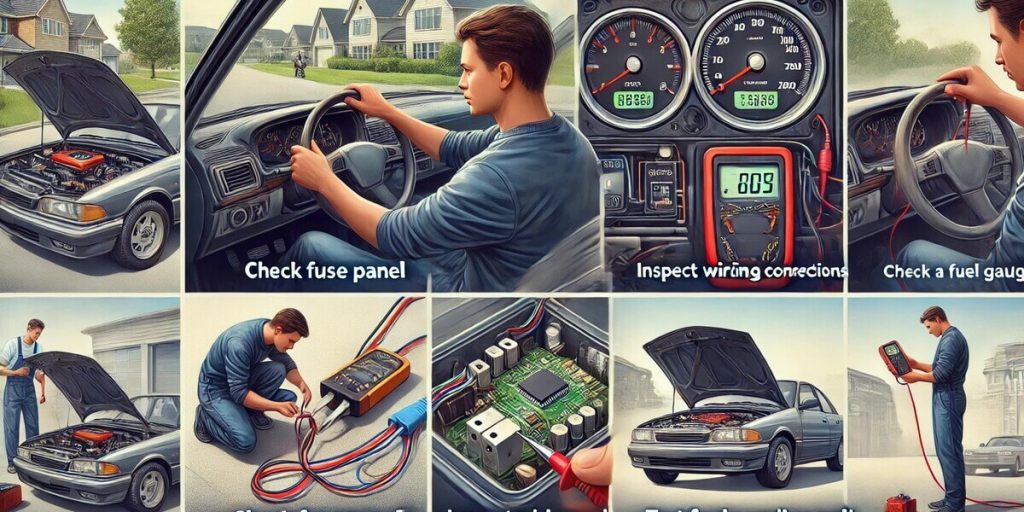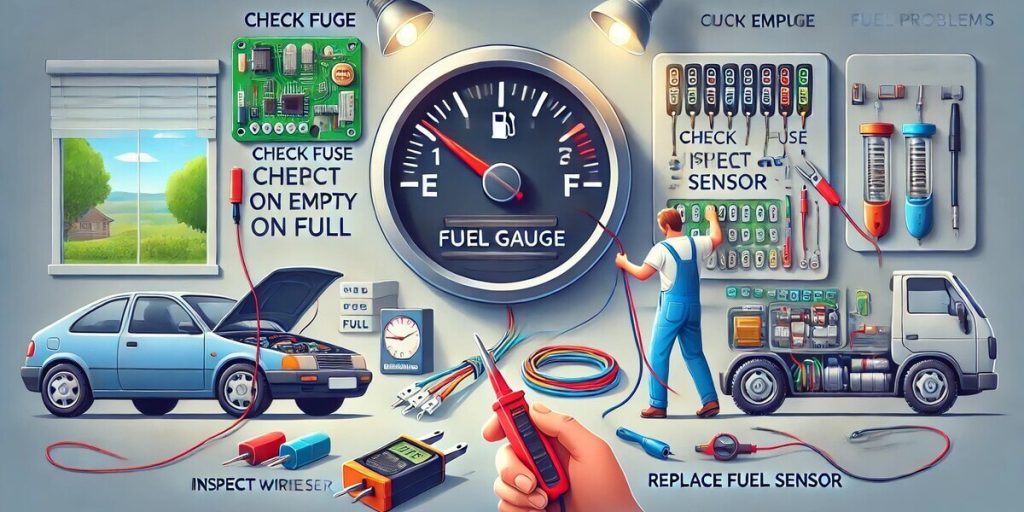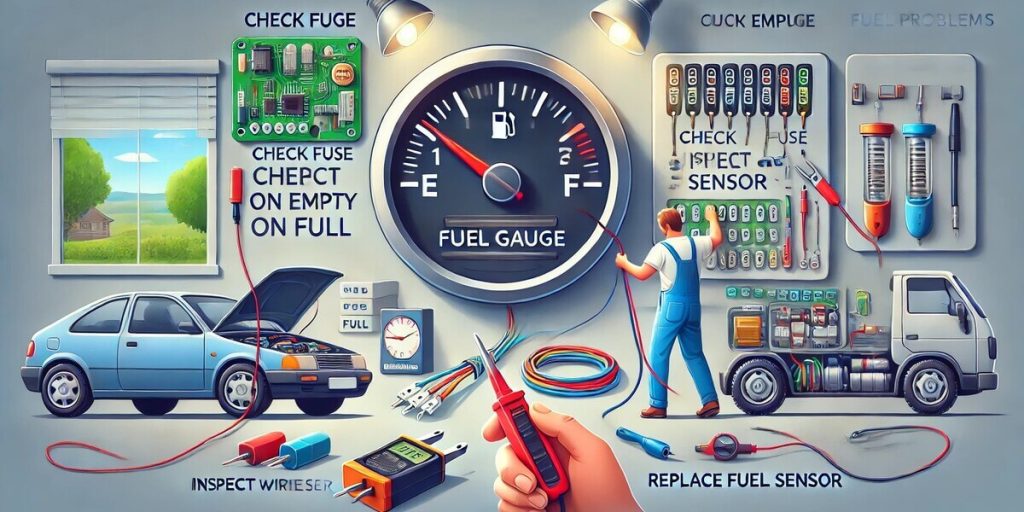Last Updated on March 8, 2025 by Mark S. Taylor
Ever had your heart skip a beat seeing your gas gauge suddenly drop to empty on a long drive? I remember that sinking feeling well, stuck on a quiet road with my fuel gauge not working and no clue how much gas I actually had left. Since then, I’ve learned exactly how to check fuel gauge issues to avoid that stress. In this guide, I’ll share simple steps and practical tips to quickly troubleshoot and fix your gauge problems. Stick with me—I’ve got easy solutions to get you back on the road safely!

Contents
Why Checking Your Fuel Gauge Matters
Ever trusted your fuel gauge and ended up stuck by the road? It happened to me—driving home late, my gauge showed plenty of fuel. But the truth was, the gauge was broken, leaving me stranded at night in the middle of nowhere. Knowing how to check fuel gauge accuracy helps avoid scary moments like these. A quick gauge check keeps you safe, calm, and on the road without trouble.
Understanding Your Vehicle’s Fuel Gauge
Ever wonder how your car’s fuel gauge really works? For a long time, I thought it was simple—like checking the battery level on my phone. But it’s actually a bit trickier. Your fuel gauge gets signals from a little sensor called the fuel sending unit, tucked away in your gas tank. It measures how much fuel you have left and sends that info right to your dashboard gauge.
But here’s the catch—older gauges aren’t always accurate. They can fool you, showing empty when you’re full or stuck on full when you’re nearly empty. Believe me, I’ve been there, confused and stressed on the side of the road. Always cross-check fuel gauge readings with mileage and fill-ups, especially in older vehicles, to stay safe and avoid surprises.
Common Reasons Your Fuel Gauge Stops Working
Ever seen your fuel gauge go wild, jumping up and down for no reason? I had this happen on a road trip once—it felt like my car was playing games with me. Turns out, there are a few usual suspects: a blown fuse, loose wires, or a faulty fuel gauge sensor. These small problems can cause your gauge to stick on empty, get stuck on full, or just stop working entirely.
You’ll know something’s wrong if the gauge never moves, even after filling up. Another clear sign is the needle bouncing all over the place, leaving you guessing how much gas you really have. The worst feeling? Watching the gauge sit lifelessly at empty, even when you know your tank is full. If you’re facing a fuel meter not working, these are your top symptoms to look out for.

Step-by-Step Guide: How to Check Fuel Gauge
Step 1 – Check Your Fuel Gauge Fuse
If your fuel gauge stops working, checking your fuse should be your first step. I learned this the hard way on a long drive when my gauge suddenly dropped to empty. Luckily, it was just a blown fuse—easy and cheap to fix. Open your fuse box (usually under the dash or hood) and find the fuse labeled “fuel gauge” using your car’s manual.
Quick Answer: Always start troubleshooting by checking the fuel gauge fuse, as it’s often the simplest and cheapest fix.
Step 2 – Check the Wiring Connections
Loose or broken wires are common reasons why your fuel gauge won’t read correctly. Once, I spent hours troubleshooting, only to find a loose wire connection. Before you get overwhelmed, carefully check the wires behind your dash and near your fuel tank. Look for loose connections, corrosion, or visible damage.
Quick Tip: Loose or damaged wiring often causes fuel gauge problems. Inspect these first before replacing any parts.
Step 3 – Checking Your Fuel Level Sensor
If your gauge is giving you weird readings, the problem might be your fuel sending unit. It’s a little float inside your tank that measures gas levels. If it’s broken, your gauge readings won’t be accurate at all. I’ve tested my sensor using a basic multimeter—it’s simpler than you think, but always take care working around fuel.
Fast Answer: You can easily test your fuel sending unit with a multimeter. Faulty readings mean it’s probably time to replace the sensor.
This step-by-step guide helps you quickly pinpoint what’s wrong with your gauge. Trust me—knowing how to troubleshoot a fuel gauge can save you time, money, and stress.

Troubleshooting & Fixing Fuel Gauge Problems
Fuel Gauge Not Working – Quick Troubleshooting Tips
I know how frustrating it feels when your fuel gauge stops working. Don’t stress—it often has a simple fix. Start by checking the fuse and wires, as these are the most common reasons for gauge problems. If that doesn’t help, a faulty fuel sensor could be the issue.
Quick Answer: When your fuel gauge stops working, first check your fuse, wiring, and fuel sensor for easy fixes.
Fixing a Stuck Fuel Gauge
Ever had your fuel gauge needle stuck at empty or full? I’ve been there, and it’s not fun guessing how much gas is left. Usually, it’s because of a sensor or mechanical issue in the fuel tank. A gentle tap on the gauge sometimes does the trick, but if not, you’ll need to get the sensor checked.
Quick Answer: A stuck fuel gauge usually points to sensor or mechanical problems and often needs professional attention.
Fuel Gauge Reads Empty or Full Constantly – Now What?
If your gauge always reads empty or full, it’s like driving blindfolded—you never know when you’ll run out. I’ve dealt with this myself, and often it’s the fuel sending unit that’s faulty. If easy checks like fuses or wires don’t fix it, it’s smart to replace the sensor soon.
Quick Answer: A fuel gauge always stuck on empty or full likely means your fuel sensor is faulty and needs replacing.
Maintaining Your Fuel Gauge and Preventing Issues
I’ve learned the hard way that prevention beats fixing problems any day. Regular checks can help you avoid headaches down the road. Keeping your fuel gauge in good shape is pretty simple. Small, consistent habits at home make a big difference in your car’s health.
Quick Answer: Regular preventive checks at home help keep your fuel gauge working well and prevent future issues.
Routine Maintenance Tips
Think of your car’s electrical system as the heartbeat keeping things running smoothly. Keep battery terminals clean, and inspect wires often to avoid unexpected fuel gauge surprises. I also use fuel additives now and then—like giving my car vitamins—to help keep the sensor working accurately. Simple care like this saves money and keeps you safely on the road.
Quick Answer: Check wires, clean battery terminals, and use fuel additives regularly to keep your fuel gauge sensor healthy and working well.
FAQs – Quick Answers on Fuel Gauge Issues
Why is My Fuel Meter Not Working?
Common causes include a blown fuse, loose wiring, or a faulty sensor. Checking these simple things often solves your fuel gauge problems quickly at home.
How Do You Fix a Gas Gauge Quickly?
Start by inspecting the fuse and wiring first—these are the easiest and quickest fixes. If problems stay, see a mechanic to safely check the sensor and gauge itself.
Is Driving With a Faulty Fuel Gauge Dangerous?
Yes, it can be risky—you may run out of gas without knowing it. Always keep track of your mileage and fuel fill-ups until you fix your faulty fuel gauge.
When Should I Replace My Fuel Level Sensor?
Replace your fuel level sensor when your gauge is always wrong or moves strangely. Accurate fuel levels keep you safe, so don’t wait too long to fix it.
How Can I Check My Car’s Fuel Gauge at Home?
To check your fuel gauge at home, inspect the fuse, wires, and sensor connections. Doing these simple checks helps you find and fix small issues quickly.
My Final Thoughts on How to Check Fuel Gauge
If you’re worried about your gas gauge, knowing how to check fuel gauge problems can save you trouble. I’ve been stuck before—it’s not fun. Check often, fix small issues quickly, and ask a pro if things get tough. Stay safe and keep rolling!
